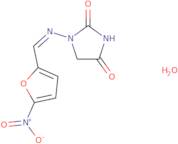Informazioni sul prodotto
- 1-((5-Nitrofurfurylidene)amino)hydantoin monohydrate
- 1-{[(1E)-(5-nitrofuran-2-yl)methylidene]amino}imidazolidine-2,4-dione
- 1-{[(E)-(5-nitrofuran-2-yl)methylidene]amino}imidazolidine-2,4-dione hydrate (1:1)
- 2,4-Imidazolidinedione, 1-(((5-nitro-2-furanyl)methylene)amino)-, monohydrate (9CI)
- 2,4-Imidazolidinedione, 1-[[(5-nitro-2-furanyl)methylene]amino]-, hydrate (1:1)
- 2,4-Imidazolidinedione, 1-[[(5-nitro-2-furanyl)methylene]amino]-, monohydrate
- Furadantin monohydrate
- Hydantoin, 1-((5-nitrofurfurylidene)amino)-, monohydrate
- Unii-E1Qi2Cqq1I
Nitrofurantoin is a synthetic derivative of nitrofuran that is a broad-spectrum antimicrobial agent. Nitrofurantoin has been used for the treatment of urinary tract infections, as well as to prevent bacterial endocarditis and other infections in people with chronic medical conditions. The drug inhibits protein synthesis by binding to ribosomes, preventing the formation of proteins vital for cell division. Nitrofurantoin can be found as an off-white crystalline powder, which is soluble in water and methanol but not in diethyl ether or chloroform. It exists in two different forms: a metastable form and a thermodynamically more stable form. The metastable form is more readily converted into its thermodynamically stable form when exposed to high temperatures, ultraviolet light, or visible light. This conversion can be prevented by the addition of xanthophylls or particle size reduction (e.g., micronization).





